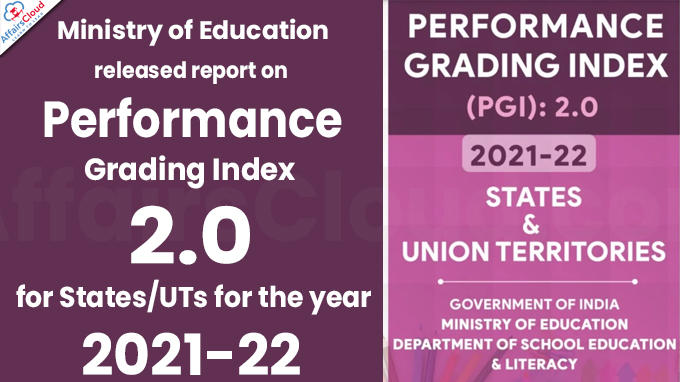 On July 7, 2023, the Department of School Education & Literacy, Ministry of Education (MoE), released the ‘Performance Grading Index (PGI): 2.0: 2021-22: States & Union Territories‘ which assesses the performance of school education system at the State/UT level by creating an index for comprehensive analysis.
On July 7, 2023, the Department of School Education & Literacy, Ministry of Education (MoE), released the ‘Performance Grading Index (PGI): 2.0: 2021-22: States & Union Territories‘ which assesses the performance of school education system at the State/UT level by creating an index for comprehensive analysis.
- It should be noted that the PGI: 2.0 is the revised version of earlier ‘PGI – State structure for 2021-22’.
What is the revision?
PGI – States/UTs was initially released for 2017-18 and has been updated until 2020-21. It focuses on Governance Processes rather than quality indicators. However, to incorporate recent initiatives of the National Education Policy (NEP) 2020, monitor Goal 4 of the Sustainable Development Goals (SDGs), and replace achieved indicators, the PGI – State structure has been revised and renamed as PGI 2.0 for 2021-22.
- Therefore grades obtained by States/UTs in previous edition of the PGIs are thus not comparable with this new edition.
How does PGI 2.0 assess?
In PGI 2.0, the sources data from Unified District Information System for Education Plus (UDISE+), National Achievement Survey (NAS), Pradhan Mantri Poshan Shakti Nirman (PM POSHAN) portal, Project Appraisal, Budgeting, Achievements and Data Handling System (PRABANDH) and Vidyanjali Portal.
- It should be noted that UDISE+ Systems initiated by Department of School Education and Literacy covering more than 14.89 lacs of schools, 95 lacs of teachers and 26.5 crores of children provides a platform to organize and classify all school data across India and build a credible database from all recognized schools imparting formal education from Pre-primary to class XII.
Key Points:
i.The new PGI 2.0 structure covers 73 indicators, focused more on qualitative assessment, digital initiatives and teacher education. It comprises of 1000 points across 73 indicators grouped into 2 categories viz., Outcomes, Governance Management (GM).
- These categories are further divided into 6 domains, viz., Learning Outcomes (LO), Access (A), Infrastructure & Facilities (IF), Equity (E), Governance Process (GP) & Teachers Education and Training (TE&T).
ii.PGI 2.0 for 2021-22 classified the States/UTs into ten grades viz., highest achievable Grade is Daksh, which is for State/UT scoring more than 940 points out of total of 1000 points. The lowest grade is Akanshi-3 which is for score up to 460.
Aim of PGI 2.0:
i.To properly track the progress of States/UTs.
ii.To propel States & UTs towards undertaking multi-pronged interventions to bring optimal education outcomes covering all dimensions.
To help States/UTs to pinpoint the gaps and accordingly prioritize areas which needs improvement.
PGI 2.0 Grades attained by various States/UTs in 2021-22
| Grades | No of states/UTs | States/ UTs attained the respective Grades |
|---|---|---|
| Daksh (941-1000) | NIL | None |
| Utkarsh (881-940) | NIL | None |
| Atti–Uttam (821- 880) | NIL | None |
| Uttam (761-820) | NIL | None |
| Prachesta– 1 (701-760) | NIL | None |
| Prachesta – 2 (641-700) | 2 | Chandigarh, Punjab |
| Prachesta – 3 (581-640) | 6 | Gujarat, Kerala, Maharashtra, Delhi, Puducherry, Tamil Nadu (TN) |
| Akanshi – 1 (521-580) | 13 | Andaman and Nicobar (A&N) Islands, Karnataka, Andhra Pradesh (AP), Lakshadweep, Chhattisgarh, Madhya Pradesh (MP), Dadra and Nagar Haveli and Daman and Diu (DNH & DD), Rajasthan, Goa, Sikkim, Haryana, West Bengal (WB), Himachal Pradesh (HP) |
| Akanshi – 2 (461-520) | 12 | Assam, Nagaland, Bihar, Odisha, Jammu & Kashmir (J & K), Telangana, Jharkhand, Tripura, Ladakh, Uttarakhand, Manipur, Uttar Pradesh (UP) |
| Akanshi – 3 (401-460) | 3 | Arunachal Pradesh (AP), Meghalaya, Mizoram |
List of Top 5 States as per Scores:
| State/UT | Score | Grade |
|---|---|---|
| Chandigarh | 659 | Prachesta-2 |
| Punjab | 647.4 | Prachesta-2 |
| Delhi | 636.2 | Prachesta-3 |
| Kerala | 609.7 | Prachesta-3 |
| Gujarat | 599 | Prachesta-3 |
Highlights:
i.None of the States/UTs has attained the highest Grade i.e., Daksh.
ii.The top-most grade attained in PGI 2.0 is Prachesta – 2. It was attained by only 2 States and UTs, namely Punjab with score of 647.4 and Chandigarh (659.0).
iii.6 States/UTs joined Grade Prachesta – 3 (score 581-640), 13 States/UTs joined grade Akanshi -1 (score 521-580), 12 States/UTs in grade Akanshi – 2 (score 461-520) and 3 States in grade Akanshi – 3 in PGI 2.0.
iv.Punjab and Chandigarh which are in Prachesta – 2, are ranked 21st and 35th respectively in terms of their geographical size amongst States/UTs.
Key Points:
i.With approximately 14.9 lakh schools, 95 lakh teachers, and nearly 26.5 crore students from diverse socio-economic backgrounds, the Indian Education System stands as one of the world’s largest.
ii.India adopted the Sustainable Development Goal 4 (SDG4) in 2015, aligning with the global education development agenda.
- SDG4 aims to ensure inclusive and equitable quality education, as well as promote lifelong learning opportunities for all by 2030.
Recent Related News:
i.Indian Institute of Technology Guwahati (IIT-G), Assam, has signed a Memorandum of Understanding (MoU) with Samagra Shiksha, Assam, (SSA) under the Rashtriya Avishkar Abhiyan of MoE to develop scientific temper and strengthen students’ ability to handle challenging environments.
ii.On 11th April 2023, Union Minister Dharmendra Pradhan, MoE, unveiled the digital version of the Employability Skills Curriculum (ES) for students enrolled in India’s
Industrial Training Institutes (ITIs) at the Future Skills Forum in New Delhi, Delhi.
About Ministry of Education (MoE):
Union Minister– Dharmendra Pradhan (Constituency- Rajya Sabha, Madhya Pradesh)
Ministers of State– Annpurna Devi (Constituency- Kodarma, Jharkhand); Dr. Rajkumar Ranjan Singh (Constituency-, Inner Manipur, Manipur); Dr. Subhas Sarkar (Constituency- Bankura, West Bengal)




